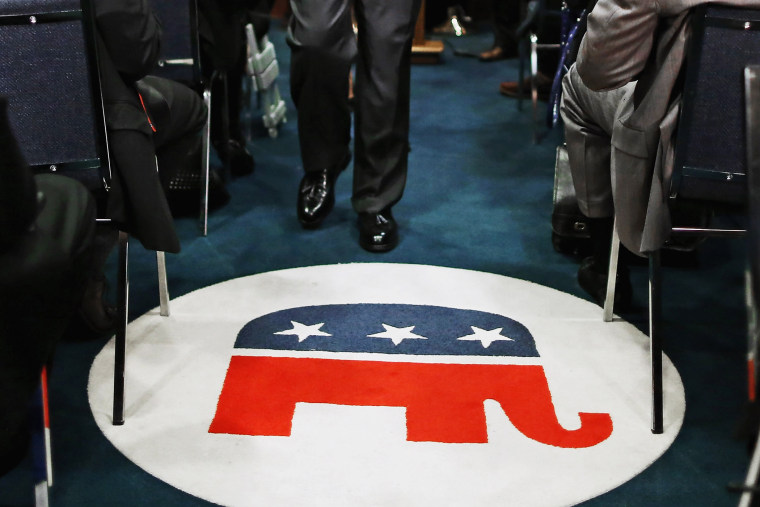After a panic from Republican donors over Democrats’ surprising fundraising strength leading up to the November midterm elections, new data shows GOP candidates in key Senate races are closing the gap thanks to a surge in advertising from big money groups.
A new report by the Wesleyan Media Project, which tracks political advertising nationally, found that Republicans ran more ads than Democrats over the last two weeks in some of the most competitive Senate contests, including Iowa, Kentucky, and Colorado, and were almost even with Democrats in Arkansas, Alaska, and North Carolina -- three other states with top-tier races.
In Colorado and Kentucky, over 56% of ads supporting GOP candidates were sponsored by independent conservative groups. In Iowa, the number was over 60%. Nationally, Democrats and their supporters still narrowly led Republicans in the total number of ads aired -- 45,000 ads to 42,000 for Republicans over the period.
“In the last two weeks we've seen a real shift,” Erika Franklin Fowler, co-director of the Wesleyan Media Project, told msnbc in an interview. “Part of that may be driven by the complaints Republicans were making [about fundraising].”
Republicans began expressing open alarm about their finances in mid-September, warning that without a late surge of cash Democrats may be able to retain their Senate majority. Karl Rove, the architect of 2012 independent spending behemoths American Crossroads and Crossroads GPS, wrote in the Wall Street Journal this month that “each passing day provides evidence as to why a GOP Senate majority is still in doubt,” citing a gap between the amount of TV time Democratic and Republican groups have reserved over the next few weeks.
Party leaders usually cry poverty in the run-up to Election Day in order to spook supporters into financing their final push. You would have no idea Democrats were as well financed as they are from reading their e-mail appeals to small donors. On the House side, recent subject lines from the Democratic Congressional Campaign Committee include “this is the end,” “Listen we’re BEGGING,” and “bad news for Democrats” even though the DCCC has significantly outraised its Republican counterpart this cycle.
But Rove’s claims weren’t without data to back them up. According to Fowler’s research, Democrats and allied groups aired a whopping 91% more Senate ads in the first two weeks of September than they did over the same period in 2010 while Republican ad buys decreased by 8%.
On the Republican side, operatives believe donors are more skeptical about handing millions to outside groups this cycle after watching Rove’s operation raise $300 million in 2012 only to lose almost every race from the presidential campaign down.
“There were a lot of donors who felt like they wasted their money, got burned big time, and were burned by consultants,” one Republican strategist told msnbc. “They’re really freaked out about where they spend their money and they have been since 2012.”
Florida-based Republican strategist Rick Wilson told msnbc that “there is a sense that the major donor community has been holding fire,” but he predicted recent polls showing momentum for GOP Senate candidates in Colorado and Iowa may encourage them to get more involved.
“As it stands, we're behind the [fundraising] curve in the last month, but this is the kind of thing that a dozen of the big boys could rectify on one conference call,” Wilson said.
Democrats’ ability to maintain parity in the ad spending wars also traces back to 2012. Even though their candidates performed well that cycle, it was largely because wealthy Democratic donors had been shaken enough by the huge dollar amounts raised by Rove and other independent groups tied to the Koch brothers that they started backing outside groups with large contributions themselves. The stigma of donating to super PACs and other "dark money" groups, who many Democratic donors once believed should be illegal, has faded since the 2010 Citizens United Supreme Court decision that kicked off their rise.
“We always looked with disdain on so-called Super PACS, so it took us a while to realize it was no good fighting with one hand tied behind your back,” Jim Manley, a Democratic consultant and former aide to Senate Majority Leader Harry Reid, told msnbc. “Since then they’ve done a good job embracing them.”
Over the last year, billionaire Tom Steyer has emerged as a kind of one-man progressive answer to the Koch brothers, pledging to spend $50 million to oppose candidates he considers insufficiently devoted to tackling climate change. Reid has also proven a prodigious fundraiser for Democratic candidates and has helped boost groups like Senate Majority PAC, which has spent over $30 million in must-win races
Besides maintaining a competitive edge on the airwaves, Democrats are strongly outspending Republicans on the ground in key races, hoping heavy investments in field operations will overcome the usual drop in turnout among young people, minorities and other Democratic voting blocs during midterm elections.
It’s still unclear how the final weeks of the ad wars will look in terms of partisan balance. Republican consultant Patrick Ruffini, whose firm Echelon Insights has been tracking media buys nationally, reported on Monday that Democrats had reserved $43 million of airtime to $26 million for Republicans and were rapidly scaling up spending in key states Colorado, Iowa, Alaska, and North Carolina compared to their opponents.
That doesn’t mean that Republicans will necessarily be outgunned, however. Ruffini noted that GOP candidates, party committees, and outside groups often purchase ad time later at a higher cost.
“It doesn’t actually look quite as bad as it’s being portrayed from the Republican side,” Ruffini told msnbc.
